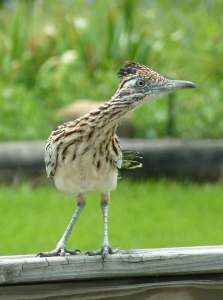Greater Roadrunner: Bird of the Week
I had just learned about the Bird of the Week, hosted at I.J. Khanewala’s blog, Don’t Hold Your Breath, and serendipitously, two Greater Roadrunners popped out of the woods to provide a good subject!
I started coming up to this farm more than 40 years ago, and started living here full time 14 years ago. During that time I have seen the roadrunners now and then, almost always in the same spot along the driveway, but I have never heard them. On the day I got these pictures, I was walking up to the mailbox, and saw two of them. One ruffled up its feathers and then jumped up into a tall pine, and during the time I watched them, it kept jumping higher and higher, turning every which way, running a little way along a branch, and then jumping again. I would guess it ended up about 20 feet/7 meters off the ground.

Greater Roadrunner, July 2023, Texas. I am not sure if this is the same one that was ruffling its feathers, or the other one I saw.
The second jumped up into a smaller pine behind my shoulder, about 10 feet/3 meters off the ground. It stayed in that same spot, and every so often it would call, and then the first one would answer back. From the way they acted, it seemed to me that the jumpy one was young and exploring, and the steady one was its parent.
It was hard for the camera to focus since the bird was so high up and it kept moving, but I was really excited to get its call on video. (There is another bird chirping throughout as well.)
This second video should be titled The Battle of the Cartoon Birds, because at the beginning and the end, you can hear a Pileated Woodpecker, which sounds like the cartoon character Woody Woodpecker, and then in the middle, you hear the roadrunner. It does sound a lot like the famous Looney Tunes bird, but rest assured that no cartoon anvils dropped out of the sky while I was filming. 🙂
The Greater Roadrunner, Geococcyx californianus, eats small snakes and lizards, rodents, and insects. It ranges from Louisiana all across the Southwest United States and Mexico. We think of them as birds of arid areas, so it seems strange that they would be here in East Texas where we get average rainfall of 47 inches a year, but according to iNaturalist, up until 8000 years ago, they were found in sparse forests, and have had to adapt to arid regions. They have been moving north and east.
The best roadrunner photos I ever got were in 2014 — we had just bought some domestic ducks, and one morning the roadrunner showed up right on our porch; I always thought it just wanted to investigate those ducks!









What a fabulous looking bird. Best profile I have seen thanks 🙂
Thank you, Brian! I do love a bird that I can identify easily from a distance, and there is nothing else around like these birds. 🙂
They do look very distinctive. I didn’t know they could fly up to roost and feed
Wonderful photos and a great story of your encounter.
I’ve never spent time in roadrunner country, so the birds are completely new to me. The last two photos look so different from the rest. There must be a large variation in colours among the birds.
I don’t think there is so much variation; I am going to guess that conditions were just perfect for those last two pictures, and with the current bunch, they were kind of in the shade, my camera is old now and it was probably low on battery….Let’s call it photographer variation. 🙂
Fun post! Thanks for sharing this.
They’re such fun birds! I rarely see one, but really enjoyed this profile–thanks and great set of shots!
Fun birds. Two come to my patio every day to visit. I’m in Palm Springs